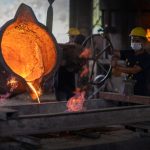 Metal heat treating is an ancient craft that has played a significant role in shaping industries and enhancing the properties of metals throughout history. From the early civilizations to modern innovations, this technique has evolved and transformed, leading to impressive advancements in various fields. In this blog, we will embark on a chronological exploration of the historical milestones in metal heat treating, unveiling the remarkable journey of this age-old practice.
Metal heat treating is an ancient craft that has played a significant role in shaping industries and enhancing the properties of metals throughout history. From the early civilizations to modern innovations, this technique has evolved and transformed, leading to impressive advancements in various fields. In this blog, we will embark on a chronological exploration of the historical milestones in metal heat treating, unveiling the remarkable journey of this age-old practice.
1. The Ancient Beginnings:
The roots of metal heat treating can be traced back to ancient civilizations, such as the Egyptians, Greeks, and Romans. These early societies developed rudimentary techniques to heat and cool metals, allowing them to manipulate metal properties and create functional tools and weapons. The use of fire and water played a crucial role in this process, as blacksmiths discovered the transformative effects of heat on metals.
2. The Advent of Iron:
One of the most significant milestones in metal heat treating was the advent of iron. Around 2000 BCE, iron began to replace bronze as the preferred metal for tool and weapon production. Blacksmiths quickly realized that by heating iron to specific temperatures and cooling it rapidly, they could dramatically improve its strength and durability. This process, known as quenching, involved plunging hot iron into water or oil, resulting in a hardened surface.
3. Medieval Craftsmanship:
During the Middle Ages, metal heat treating techniques continued to evolve, driven by advancements in metallurgy and the growing demands of warfare. Medieval blacksmiths perfected the art of tempering, a process that involves reheating quenched metal to a lower temperature and then cooling it slowly. This technique provided a balance between hardness and toughness, making weapons and armor more effective on the battlefield.
4. Industrial Revolution and Steel:
The industrial revolution in the 18th and 19th centuries brought significant changes to metal heat treating. With the advent of steam-powered machinery, the demand for stronger and more durable materials surged. This led to the development of new heat treating methods, such as annealing, which involved heating steel to a high temperature and then cooling it slowly. This process refined the internal structure of the metal, making it more pliable and less prone to brittleness.
5. Rise of the Case Hardening:
In the late 19th century, the steel industry saw the rise of a new heat treating technique known as case hardening. This method involved improving the wear resistance of low carbon steel by introducing a high carbon layer on the surface. By heating the steel in the presence of carbon-rich materials and then quenching it, blacksmiths achieved a hardened exterior while retaining a softer and more ductile core.
6. Advancements in Metallurgy and Alloying:
The 20th century marked a paradigm shift in metal heat treating, fueled by significant advancements in metallurgy and alloying techniques. Scientists and engineers began to experiment with different alloying elements, such as chromium, nickel, and molybdenum, to enhance the mechanical and chemical properties of metals. This led to the development of specialized heat treating processes, including nitriding, carburizing, and martempering, which allowed for precise control over the material’s microstructure and performance.
7. Modern Innovations:
In recent decades, metal heat treating has continued to evolve with the introduction of cutting-edge technologies. With the emergence of vacuum furnaces, precise temperature control and the prevention of oxidation became possible, enabling the heat treating of exotic metals like titanium and superalloys. Additionally, advancements in computer simulation and modeling have empowered engineers to optimize heat treatment processes, reducing waste and energy consumption.
8. The Future of Metal Heat Treating:
Today, metal heat treating remains an indispensable part of numerous industries, including aerospace, automotive, and energy sectors. As technology continues to advance, we can expect further innovations in heat treating methods, such as laser heat treating and 3D printing of metals with tailored properties. These developments will undoubtedly shape the future of metal heat treating, pushing the boundaries of what is possible in terms of material performance and application.
Summary
Metal heat treating has come a long way from its humble beginnings in ancient civilizations to its current state of advanced technologies. Through centuries of experimentation and innovation, this ancient craft has revolutionized industries and transformed the properties of metals, enabling them to meet the ever-increasing demands of our modern world. As we glance back at this historical journey, we recognize the remarkable impact metal heat treating has had on our society and its limitless potential for the future.
